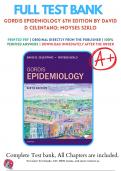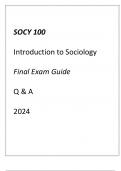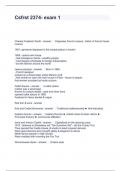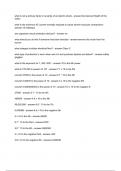PRINTED PDF | ORIGINAL DIRECTLY FROM THE PUBLISHER | 100%
VERIFIED ANSWERS | DOWNLOAD IMMEDIATELY AFTER THE ORDER
For more Test banks, ATI, HESI exams, and more contact us.
FULL TEST BANK
G o r d i s E p i d e m i o l o g y 6 t h E d i t i o n B y D a v i d
D C e l e n t a n o ; M o y s e s S z k l o
Complete Test bank, All Chapters are included. Table of content
Chapter 1: Introduction
Chapter 2: The Dynamics of Disease Transmission
Chapter 3: The Occurrence of Disease: I. Disease Surveillance and Measures of Morbidity
Chapter 4: The Occurrence of Disease: II. Mortality and Other Measures of Disease
Impact
Chapter 5: Assessing the Validity and Reliability of Diagnostic and Screening Tests
Chapter 6: The Natural History of Disease: Ways of Expressing Prognosis
Chapter 7: Observational Studies
Chapter 8: Cohort Studies
Chapter 9: Comparing Cohort and Case-Control Studies
Chapter 10: Assessing Preventive and Therapeutic Measures: Randomized Trials
Chapter 11: Randomized Trials: Some Further Issues
Chapter 12: Estimating Risk: Is There an Association?
Chapter 13: More on Risk: Estimating the Potential for Prevention
Chapter 14: From Association to Causation: Deriving Inferences From Epidemiologic
Studies
Chapter 15: More on Causal Inference: Bias, Confounding, and Interaction
Chapter 16: Identifying the Roles of Genetic and Environmental Factors in Disease
Causation
Chapter 17: Using Epidemiology to Evaluate Health Services
Chapter 18: Epidemiologic Approach to Evaluating Screening Programs
Chapter 19: Epidemiology and Public Policy
Chapter 20: Ethical and Professional Issues in Epidemiology Chapter 01: Introduction Celentano: Gordis Epidemiology, 6th Edition Test Bank MULTIPLE CHOICE 1.Which of the following is an example of tertiary prevention?
a.Vaccination for rotavirus for children younger than the age of 1 year
b.Surgical amputation of an extremity with osteosarcoma (bone cancer)
c.Screening for gestational diabetes after 24 wee ks of pregnancy
d.Sexual education program in elementary schools
e.Increasing taxes for buying cigarettes
ANS: B Surgical amputation of an extremity with osteosarcoma (bone cancer) is an example in which when a disease is present the treatment (amputat ion) is done to reduce the impact of disease by preventing the tumor from dissemination. Vaccination for rotavirus for children younger than the age of 1 year , sexual education program in elementary schools , and increasing taxes for buying cigarettes represent examples of primary prevention. Screening for gestational diabetes after 24 weeks of pregnancy is an example of secondary prevention. 2.This historic character observed that childbed fever mortality was more common a mong
women treated by physicians and medical students compared with women treated by midwives. Based on his observations, he implemented a hand wash policy that resulted in a decrease in mortality. Name the character that we are talking about . a.John Sno w
b.Edward Jenner
c.D.A. Henderson
d.Leon Gordis
e.Ignaz Semmelweis
ANS: E Ignaz Semmelweis identified that medical students and physicians transmitted the disease by not washing their hands after examining bodies at autopsies and conducting multiple examinations in the clinic. 3.Thanks to the contributions of Edward Jenner, the following disease was eradicated later
by efforts organized by D.A. Henderson:
a.Cholera
b.Smallpox
c.Chickenpox
d.Polio
e.Zika
abirb.com/test abirb.com/test abirb.com/test abirb.com/test abirb.com/test abirb.com/test abirb.com/test abirb.com/test abirb.com/test abirb.com/test abirb.com/test abirb.com/test abirb.com/test abirb.com/test abirb.com/test abirb.com/test abirb.com/test abirb.com/test abirb.com/test abirb.com/test Test Bank Copyright © 2020 by Elsevier, Inc. All rights reserved. 1-2
ANS: B Smallpox was er adicated in 1980. Edward Jenner vaccinated James Phipps in 1796 against smallpox. Almost 200 years later, the World Health Organization ( WHO ) commissioned D.A. Henderson to lead the efforts to eradicate the disease.
4. Over the past century, a marked decl ine in the mortality rates of many infectious diseases
has been observed. Which of the following is the most likely reason for the observed decline
in mortality rates from common infectious diseases?
a.Development of penicillin
b.Development of insulin
c.Development of vaccines
d.Improvement in social conditions
e.Worse sanitation and unsafe water
ANS: D Although medical treatments potentially helped in the decrease of infectious diseases, the advancement in social conditions played a major role. These improvements include better sanitation, safe disposal of waste, better nutrition, and improvement in housing conditions. abirb.com/test abirb.com/test abirb.com/test abirb.com/test abirb.com/test abirb.com/test abirb.com/test abirb.com/test abirb.com/test abirb.com/test abirb.com/test abirb.com/test abirb.com/test abirb.com/test abirb.com/test abirb.com/test abirb.com/test abirb.com/test abirb.com/test abirb.com/test Chapter 02: The Dynamics of Disease Transmission Celentano: Gordis Epidemiology, 6th Edition Test Bank MULTIPLE CHOICE 1.Which term most accurately describes the following definition? “The occurrence in a
community or region of cases of an illness, specific health -related behavior, or other health -
related events clearly in excess of normal expectancy.” [Porta M, ed. A Dicti onary of
Epidemiology . New York: Oxford University Press ; 2014.]
a.Endemic
b. Epidemic
c. Pandemic
d. Attack rate
e. Incubation period
ANS: B An epidemic is the occurrence of health-relate d events in a com munity or region , in clear excess of normal expectation . Endemic is not true because it is defined a s the constant occurrence of a disease, disorder, or noxious infectious agent in a geographic area or population group. Pandemic is as an epidemic occurring over a very wide are a, crossing international boundari es, and usually affecting a large number of people. Attack rate is not true because it is defined as number of people at risk in whom a certain illness develops ove r total number of people at risk. Incubation period is not true bec
ause it is the interval from receipt of infection to the time of onset of clinical illness (the onset of recognizable symptoms). 2. What is the most accurate definition of the incubation period (of an infectious disease)?a.The time of onset of clinical illness or the onset of recognizable symptoms
b. The interval from receipt of infection to the time of onset of clinical illness (the onset of
recognizable symptoms)
c. The time of invasion by an infectious agent
d. The time between initiation of infection and first shedding or excretion of the agent
e. The period between exposure and the onset of infectiousness
ANS: B The incubation period is define d as the interval from receipt of infection to the time of onset of clinical illness (the onset of recognizable symptoms); i n other words, the time betwe en the moment of developi ng symptoms and the moment of invasion by an infe ctious agent. “The time of onset of clinical illness or the onset of recognizable symptoms” is not true as it corresponds to “time of onset.” “The time of invasion by an infectious agent” is not true as it corresponds to “time of infection.” “The time between initiati on of infection and first shedding or excretion of the agent” and “The period betwee n exposure and the onset of infecti
ousness” are not true as they correspond t o the latent period. (The latent period i s Copyright © 2020 by Elsevier, Inc. All rights reserved. abirb.com/test abirb.com/test abirb.com/test abirb.com/test abirb.com/test abirb.com/test abirb.com/test abirb.com/test abirb.com/test abirb.com/test abirb.com/test abirb.com/test abirb.com/test abirb.com/test abirb.com/test abirb.com/test abirb.com/test abirb.com/test abirb.com/test abirb.com/test Test Bank Copyright © 2020 by Elsevier, Inc. All rights reserved. 2-2
focusing on the onset of infectiousness, but the incuba tion period is focusing on the onset of the symptom.) 3.There was a food poisoning outbreak on April 1, 2018, at the City Z Food Safety
Conference. There were 1 ,000 people registered for the conference with luncheon, 100
volunteers to host attendees , and 50 people who served the luncheon during the conference.
Except for 50 people who served the food, all of the participants and volunteers ate the food
from the luncheon at the conference on April 1, 2018. Based only on the information given in
this question, how many people are at risk in this food poisoning outbreak?
a.1,000
b. 1,100
c. 1,150
d. 150
e. 50
ANS: B People at risk in this outbreak are people who were exposed to the food at the conference. Even though 1,150 people were at the conference , 50 people who served the food did not eat the f
ood. Therefore we have to exclude those 50 people. 4. There was a food pois oning outbreak on April 1, 2018, at the Cit y Z Food Safety Conference. There were 1,000 people registered for the conference with luncheon, 100 volunteers to host attendees, and 50 people who served the luncheon during the conference. Except for 50 people who and volunteers ate the food from the luncheon at the conference on April 1, 2018. After an initial outbreak of food poisoning is reported, an epidemiologist sends surveys to all people at risk to investigate the cause. However, only 900 people among those at risk answer the survey. After analysis of 900 survey results, the epidemiologist concludes that the most suspected foods in the outbreak are pepperoni pizza and meatball spaghetti. What is the overall attack rate for those who ate meatball spaghetti? Use the following table to answer the question.
Summary of Survey Responses
Number of people who developed the case definition symptoms Number of people who ate the food Pepperoni pizza only 113 275 Meatball spaghetti only 62 375 Both pepperoni pizza and meatball spaghetti 57 150 Neither of pepperoni pizza or meatball spaghetti 10 100 a.41%
b. 38%
c. 27%
abirb.com/test abirb.com/test abirb.com/test abirb.com/test abirb.com/test abirb.com/test abirb.com/test abirb.com/test abirb.com/test abirb.com/test abirb.com/test abirb.com/test abirb.com/test abirb.com/test abirb.com/test abirb.com/test abirb.com/test abirb.com/test abirb.com/test abirb.com/test Test Bank 2-3
d. 40%
e. 23%
ANS: E To calculate the food -specific attack rate, we need to define how many people are exposed to the specific food and how many people develop the symptoms in the case definition. In this question, we are asking about “overall” attack rate in those people who ate meatball spaghetti, so we have to add “meatball spaghetti only ” and “both pepperoni pizza and meatball spaghetti ” to get the overall rate. Which is 525 (375 plus 150 ), who are at risk of exposure, and 119 (62 plus 57 ), who developed the symptoms, corresponding to 23% of attack rate. 5.There was a food poisoning outbreak on April 1, 2018, at the City Z Food Safety
Conference. There were 1 ,000 people registered for the conference w ith luncheon, 100
volunteers to host attendees , and 50 people who served the luncheon during the conference.
Except for 50 people who served the food, all of the participants and volunteers ate the food
from the luncheon at the conference on April 1, 2018. After an initial outbreak of food
poisoning is report ed, an epidemiologist sends surveys to all people at risk to investigate the
cause. However, only 900 people among those at risk answer the survey. After analysis of
900 survey results, the epidemiologist concludes that the most suspected foods in the
outbreak are pepperoni pizza and meatball spaghetti. What is the most suspected food for
food poisoning after cross -tabulation? Use the following table to answer the question.
Summary of Survey Responses
number of peopledeveloped the case definition symptoms Number of people who ate the food Pepperoni pizza only 113 275 Meatball spaghetti only 62 375 Both pepperoni pizza and meatball spaghetti 57 150 Neither of pepperoni pizza or meatball spaghetti 10 100 a.Pepperoni pizza only
b. Meatball spaghetti only
c. Both pepperoni pizza and meatball spaghetti
d. Neither pepperoni pizza nor meatball spaghetti
e. We cannot determine the cause of food based on this information
ANS: A Pepperoni pizza only attack rate is 41.09% (113 divided by 275), and meatball spaghetti only is 16.53% (62 divided by 375). The attack rate o f both pepperoni pizza and meatball spaghetti is 38.00% (57 divided by 150). Some may choose both of the m which are the most suspected Copyright © 2020 by Elsevier, Inc. All rights reserved. Gordis Epidemiology 6th Edition Celentano Test Bank
abirb.com/test abirb.com/test abirb.com/test abirb.com/test abirb.com/test abirb.com/test abirb.com/test abirb.com/test abirb.com/test abirb.com/test abirb.com/test abirb.com/test abirb.com/test abirb.com/test abirb.com/test abirb.com/test abirb.com/test abirb.com/test abirb.com/test abirb.com/test Test Bank 2-4
food. If both the foods were the most suspected food, we should have a higher attack rate in meatball spaghetti only group as well. 6.What is the name of the occurrence of a clearly higher than expected number of cases of a
disease within a limited geographical region?
a.Pandemic
b.Epidemic
c.Endemic
d.Zoonosis
e.Attack rate
ANS: B The definition of epidemic is precisely the occurrence of a clearly higher than habitual number of cases of a disease within a certain geographic region. Pandemic refers to a worldwide epidemic. Endemic refers to the habitual occurrence. Zoonosis describes a disease that is transmitted from animals to humans. 7.Malaria is a parasitic disease transmitted by the Anopheles mosquito bite. This mode of
transmission is called
a.direct.
b.single exposure.
c.multiple exposure.
d.mosquitosis .
e.vector.
ANS: E Diseases transmitted by mosquitos are called vector borne. Direct, single exposure , and multiple exposure represent other modes of transmission, and mosquitosis does not exist. 8.An outbreak of measles oc curred in City A. There were 1,000 confirmed cases among
children younger than 10 years old. Unfortunately, 50 children died of measles. Fifty
represent 5% of the total number of cases. What concept is being illustrated in this example ?
a.Attack rate
b.Secondary attack rate
c.Case-fatality rate
d.Incubation period
e.Subclinical disease
ANS: C Case-fatality rate is defined as the proportion of people who die of a disease, among the total number of cases of that disease . Attack rate and se condary attack rate refe r to the proportion of people (at risk) who develop a disease among the total number of people who were at risk for the disease . Incubation period describes the period between the origin of disease and onset of cli
nical symptom s. Subclinical disease describes a disease that does not manifest clinically. Copyright © 2020 by Elsevier, Inc. All rights reserved. abirb.com/test abirb.com/test abirb.com/test abirb.com/test abirb.com/test abirb.com/test abirb.com/test abirb.com/test abirb.com/test abirb.com/test abirb.com/test abirb.com/test abirb.com/test abirb.com/test abirb.com/test abirb.com/test abirb.com/test abirb.com/test abirb.com/test abirb.com/test Test Bank Copyright © 2020 by Elsevier, Inc. All rights reserved. 2-5
9.During the conquest of Mexico, outbreaks played an important role that favored the
Spaniards. There were several outbreaks of smallpox that killed thousands of natives.
Smallpox was introduced into America by the Europeans. Why were the natives particularly
afflicted by smallpox outbreaks?
a.Among natives, the proportion of susceptibles was higher .
b.Among Spaniards, the proportion of im munes was extremely low .
c.Spaniards had the cure for smallpox .
d.Natives had a gene that made them more prone to die from smallpox .
e.Spaniards were protected from smallpox because they had armors .
ANS: A Because natives were not introduced to the sm allpox virus until after the Spaniards arrived, all of them were su sceptibles. In a population with a higher proportion of su sceptibles, outbreaks can initiate and spread easily. Spaniards had a better balance between susceptibles and immunes; therefore th e likelihood of an outbreak happening among them was much lower. 10.The population of Oriol City in June 2018 was 612,437. According to the Oriol City’s
health department, there were 329 new cases of Raven’s disease during 2018. Counting those
new cases, by December 31 it was estimated that there were 6580 persons with Raven’s
disease in Oriol City. What was the incidence rate of Raven’s disease in 2018?
a.26 per 100,000 population
b.33 per 100,000 population
c.54 per 100,000 population
d.1074 per 10 0,000 population
e.5000 per 100,000 population
ANS: C The numerator to calculate the incidence rate is the total number of new cases (329), and the denominator is the total number of people who were at risk of developing the condition (in this case we use the population at the middle of that period, 612,437). We express the incidence rate per 100,000 to avoid the decimals: 329/612,437 = 0.000537 100,000 = 53.7. 11.The population of Oriol City in June 2018 was 612,437. According to the Oriol City’s
health department, there were 329 new cases of Raven’s disease during 2018. Counting those
new cases, by December 31 it was estimated that there were 6580 persons with Ra ven’s
disease in Oriol City. What was the prevalence of Raven’s disease in 2018?
a.26 per 100,000 population
b.33 per 100,000 population
c.54 per 100,000 population
d.1074 per 100,000 population
e.5000 per 100,000 population
ANS: D abirb.com/test abirb.com/test abirb.com/test abirb.com/test abirb.com/test abirb.com/test abirb.com/test abirb.com/test abirb.com/test abirb.com/test abirb.com/test abirb.com/test abirb.com/test abirb.com/test abirb.com/test abirb.com/test abirb.com/test abirb.com/test abirb.com/test abirb.com/test Test Bank Copyright © 2020 by Elsevier, Inc. All rights reserved. 2-6
To calculate the prevalence of Raven’s disease, we use the total number of cases present at the end of the period (6580) divided by the total number of people in that city (612,437), thus: 6580/612,437 = 0.01074 100,000 = 1074. abirb.com/test abirb.com/test abirb.com/test abirb.com/test abirb.com/test abirb.com/test abirb.com/test abirb.com/test abirb.com/test abirb.com/test abirb.com/test abirb.com/test abirb.com/test abirb.com/test abirb.com/test abirb.com/test abirb.com/test abirb.com/test abirb.com/test abirb.com/test








